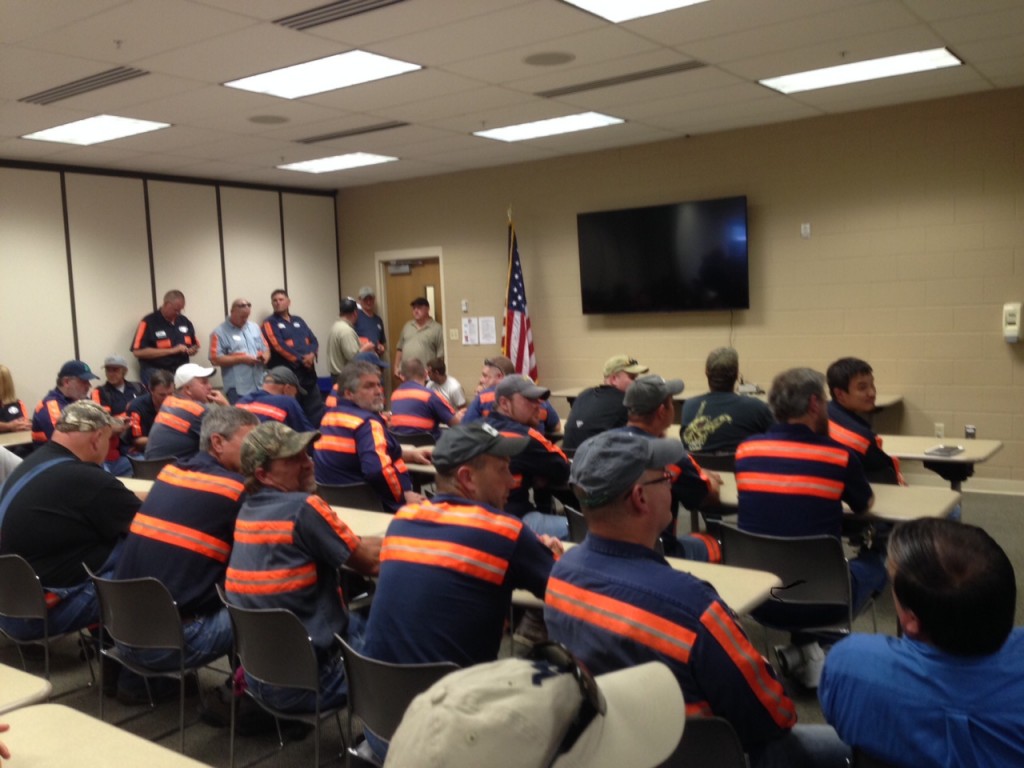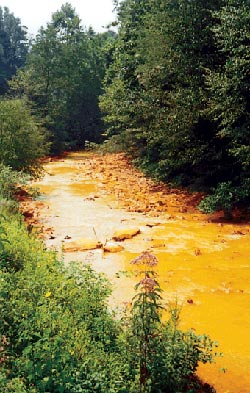Water quality: Are we learning from the past?
July 23, 2015 by Ken Ward Jr.
Dozens of miners turned out this week for a state DEP public hearing on water quality standards. Photo by Ken Ward Jr.
In the wake of Tuesday’s state Department of Environmental Protection public hearing on water quality standards, it seems a shame to allow the irony of the evening’s events to go unmentioned.
As the photo above shows, the West Virginia Coal Association did a find job of turning out a few dozen coal miners to sit at the hearing to show their support for the industry-pushed rule changes on aluminum and selenium that DEP (under orders from the Legislature) has proposed. Only two of the miners spoke, but I’m sure DEP got the message.
Still, let’s remember that there were really two sets of water quality rules on the agenda for the public hearing. The first were the changes that environmental groups say will clearly weaken pollution limits for aluminum and selenium and complicate the enforcement for both toxic chemicals. The other is a pair of site-specific water quality variances that DEP says are needed to allow it a broader — and less bound by court-mandated permit requirements — approach to cleaning up streams in the Tygart and Cheat river watersheds that continue to be burdened by acid mine drainage from previous coal mining activities.
Now, the industry’s argument in favor of the first set of changes — especially the one for selenium — is that the state’s current limits are unnecessarily stringent, and are making things even worse for the coal industry. The politicians who showed up with Tuesday night’s crowd of miners kept having to stop themselves from turning the event into another bash-Obama and the EPA rally, rather than a hearing at which the state DEP was giving mine operators what they want.
The thing is, while it’s true that citizen group lawsuits and court ruling have forced companies to spend money cleaning up selenium pollution — in one case helping push Patriot Coal to abandon mountaintop removal — it’s also true that scientists have found selenium is a serious problem for aquatic life in West Virginia streams (see here and here).

And as for the acid mine drainage issue that DEP officials very rightly want to find a better way to deal with, well, one must be careful not to pretend that this particular problem was all caused — as one citizen group speaker suggested at the DEP hearing — long before any of us were alive. It’s true that AML sites related to mining that happened prior to passage of the 1977 surface mining act remain a major issue, the state’s “Special Reclamation Fund,” which handles sites that mine operators abandoned after passage of that law, have plenty of their own water pollution problems. And citizen groups have had to pull DEP along for years trying to improve the agency’s commitment to treatment that pollution properly.
In fact, as the coal industry’s financial situation continues to worsen, many observers around the country are increasingly worried about the ability of state reclamation funds to clean up the messes that could be left behind should more operators go belly up. Locally, Roger Calhoun of the federal Office of Surface Mining Reclamation and Enforcement’s Charleston field office, has been raising this very issue with the West Virginia DEP.
The connection between the industry’s efforts to weaken water quality standards, and the state’s search for some financially viable way to clean up acid mine drainage from past mining should be pretty clear. If it’s not, that old saying about the way out of a hole is to first stop digging comes to mind again.

 Subscribe to the Coal Tattoo
Subscribe to the Coal Tattoo
